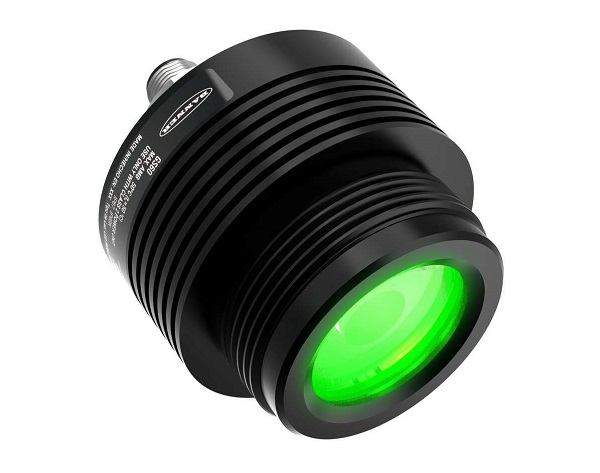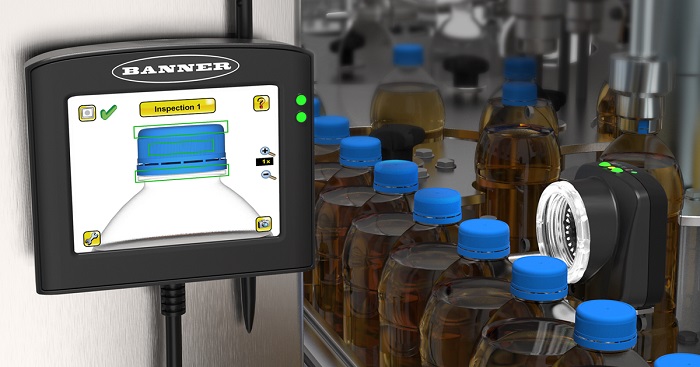I Can See the Light! Introducing Banner’s New GS60 Guide Spotlight
Object detection and operator interfaces can be simplified with the new dedicated, high-intensity light indicator with configurable colors for a wide range of optical applications.
Banner has recently introduced the GS60, a new guide spotlight for high-intensity lighting in various applications such as detection tasks, operator guidance indicators, and status warnings for equipment like a pressed e-stop.
Specifications and Functionalities of the GS60 Series Light
This spotlight offers a range of functionalities, including discrete (high/low/off) options, adjustable strobing with pulse width modulation, and dimming capabilities. It is easy to deploy using a 4-pin or 5-pin M12 integral male cable, the industry standard for sensors and other 24-volt supplied components in industrial systems. The GS60 also features a robust anodized aluminum housing and a polycarbonate window, ensuring reliability even in harsh conditions.

Banner Engineering’s new GS60GL4Q. Image used courtesy of Banner Engineering
The current consumption for these LED modules is rated below 0.5 amps, even for the highest intensity models at the lowest (12 volts) input, while each color and higher voltage input will only further reduce the rated current.
When it comes to lighting for specific applications, the color chosen must match the criteria. It's not just about aesthetics but also functionality. The right color can enhance contrast, differentiate materials, and reduce glare and reflections. That's why Banner has introduced seven color options to the GS60 product line, ensuring the right tool for every job. The available options are daylight white, red, green, blue, yellow, infrared, and ultraviolet.
Differences in Colors: Application Examples
White
White light is ideal for general and evenly distributed illumination applications, such as barcode reading and package inspection. It provides consistent and bright illumination for barcode reading and ensures uniform lighting for package inspection, allowing for detecting defects, labels, and other critical details.
Red
Red light suits tasks requiring high contrast and less glare. Some examples include examining surfaces and food. Red light makes it easier to spot surface imperfections such as scratches or dents on items, which helps maintain quality control. In food inspection, red light can emphasize bruises or blemishes on fruits and vegetables.
Green
Greenlight is particularly useful for tasks requiring high contrast and visibility with certain materials. When a green light is used in electronics production, it can effectively reveal flaws such as soldering problems or tiny cracks on circuit boards, thus guaranteeing the reliability of the components. Moreover, green light is less likely to cause eye strain during extended periods, making it well-suited for activities that demand sustained concentration.
Blue
Blue light is ideal for high-precision detection and imaging. It is used in fluorescence inspection to reveal hidden features, in dental and medical imaging to enhance contrast and clarity, and in tasks that demand detailed inspection and accurate diagnostics.

The reflection of a specific wavelength can provide sufficient contrast for image detection, even in low-contrast situations. Image used courtesy of Banner Engineering
Yellow
Yellow light enhances contrast, reduces glare, and improves visibility, especially in display-intensive settings with low ambient lighting. Yellow light gives similar results to daylight white light but doesn’t do as well with differentiating colors or materials.
Infrared
In situations where human vision is insufficient, like night vision and agricultural monitoring, infrared light is essential. In night vision, infrared light helps detect objects and movement in complete darkness by providing light that can't be seen. In agricultural monitoring, infrared light checks plant health by finding heat and moisture levels, giving important information about crop conditions.
Ultraviolet
Ultraviolet light is crucial for applications that require revealing hidden details. In document verification, ultraviolet light can expose security features like invisible watermarks and UV-reactive inks under standard lighting, ensuring the authenticity of identification cards, currency, and essential documents.

 Facebook
Facebook Google
Google GitHub
GitHub Linkedin
Linkedin








